How Did The Invention Of Oil Paint In Metal Tubes Change Art In The 1800s?
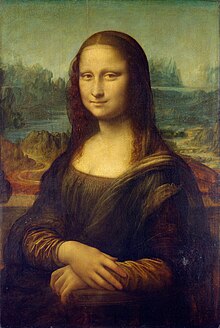
Oil painting is the process of painting with pigments with a medium of drying oil as the binder. It has been the most common technique for artistic painting on wood console or canvass for several centuries, spreading from Europe to the balance of the world. The advantages of oil for painting images include "greater flexibility, richer and denser colour, and a wider range from light to dark".[one] But the process is slower, especially when i layer of paint needs to be allowed to dry out before another is applied.
The oldest known oil paintings were created by Buddhist artists in Afghanistan and date back to the 7th century Advertising.[2] The technique of binding pigments in oil was after brought to Europe in the 15th century, about 900 years afterwards. The adoption of oil paint past Europeans began with Early Netherlandish painting in Northern Europe, and by the summit of the Renaissance, oil painting techniques had almost completely replaced the use of tempera paints in the majority of Europe. Oil paint was used past Europeans for painting statues and woodwork from at least the 12th century, but its common utilise for painted images began with Early Netherlandish painting in Northern Europe, and by the height of the Renaissance, oil painting techniques had almost completely replaced the utilize of egg tempera paints for panel paintings in most of Europe, though non for Orthodox icons or wall paintings, where tempera and fresco, respectively, remained the usual pick.
Usually used drying oils include linseed oil, poppy seed oil, walnut oil, and safflower oil. The choice of oil imparts a range of properties to the paint, such every bit the amount of yellowing or drying time. The pigment could be thinned with turpentine. Certain differences, depending on the oil, are also visible in the sheen of the paints. An creative person might utilise several different oils in the same painting depending on specific pigments and effects desired. The paints themselves also develop a particular consistency depending on the medium. The oil may be boiled with a resin, such as pine resin or frankincense, to create a varnish prized for its torso and gloss. The paint itself can exist molded into different textures depending on its plasticity.
Techniques [edit]

Thin blade used for the application or removal of pigment. Can also be used to create a mixture of various pigments.
Traditional oil painting techniques frequently begin with the artist sketching the subject area onto the canvas with charcoal or thinned pigment. Oil paint is ordinarily mixed with linseed oil, artist course mineral spirits, or other solvents to make the paint thinner, faster or slower-drying. (Because the solvents thin the oil in the paint, they tin can also be used to clean paint brushes.) A basic rule of oil paint application is 'fat over lean', meaning that each additional layer of paint should contain more oil than the layer below to allow proper drying. If each boosted layer contains less oil, the concluding painting will crack and skin. The consistency on the canvass depend on the layering of the oil pigment. This rule does not ensure permanence; information technology is the quality and type of oil that leads to a strong and stable paint motion picture.
At that place are other media that can be used with the oil, including cold wax, resins, and varnishes. These additional media can assist the painter in adjusting the translucency of the paint, the sheen of the paint, the density or 'body' of the paint, and the ability of the paint to hold or conceal the brushstroke. These aspects of the pigment are closely related to the expressive capacity of oil pigment.
Traditionally, paint was well-nigh often transferred to the painting surface using paintbrushes, but there are other methods, including using palette knives and rags. Palette knives can scrape off whatever paint from a sail, it can also exist used for application. Oil paint remains wet longer than many other types of artists' materials, enabling the creative person to change the color, texture or form of the figure. At times, the painter might fifty-fifty remove an entire layer of paint and brainstorm anew. This can exist washed with a rag and some turpentine for a time while the pigment is wet, but after a while the hardened layer must exist scraped off. Oil pigment dries by oxidation, not evaporation, and is usually dry to the touch within a span of two weeks (some colors dry within days).
History [edit]
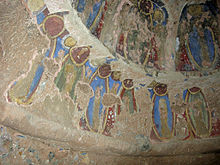
A section of the earliest discovered oil paintings (~ 650AD) depicting buddhist imagery in Bamiyan, Afghanistan

A detail from the oldest oil paintings in the world (~ 650 AD) a series of Buddhist murals created in Bamiyan, Afghanistan.
The primeval known surviving oil paintings are Buddhist murals created circa 650AD in Bamiyan, Afghanistan. Bamiyan is an historic settlement along the silk route and is famous for the Bamiyan Buddhas, a series of giant statues, backside which rooms and tunnels are carved from the rock. The murals are located in these rooms. The artworks brandish a wide range of pigments and ingredients, and even included the use of a final varnish layer. The refinement of this painting technique and the survival of the paintings into the present day suggests that oil paints had been used in Asia for some fourth dimension before the 7th century. This technique of binding pigments in oil, first seen in the Bamiyan cave paintings of South Asia, was later brought to Europe near 900 years after, in the 15th century. Europeans adopted the technique with Early Netherlandish painting in Northern Europe, and subsequently, during the Renaissance, oil painting techniques had nigh completely replaced the earlier utilise of tempera paints in the majority of Europe. [3] [4] [5]
Nearly European Renaissance sources, in item Vasari, falsely credit northern European painters of the 15th century, and Jan van Eyck in particular, with the invention of oil paints[6] However, Theophilus (Roger of Helmarshausen?) conspicuously gives instructions for oil-based painting in his treatise, On Various Arts, written near 1125.[seven] At this flow, it was probably used for painting sculptures, carvings and wood fittings, perhaps especially for outdoor use. Outdoor surfaces and surfaces like shields—both those used in tournaments and those hung as decorations—were more durable when painted in oil-based media than when painted in the traditional tempera paints. Withal, early on Netherlandish painting with artists like Van Eyck and Robert Campin in the early and mid-15th century were the first to make oil the usual painting medium, and explore the use of layers and glazes, followed by the rest of Northern Europe, and only then Italy.
Such works were painted on wooden panels, but towards the cease of the 15th century canvas began to be used as a support, as information technology was cheaper, easier to ship, immune larger works, and did not require complicated preliminary layers of gesso (a fine blazon of plaster). Venice, where sail-canvas was easily available, was a leader in the move to canvas. Minor cabinet paintings were also made on metal, particularly copper plates. These supports were more than expensive but very firm, allowing intricately fine item. Often printing plates from printmaking were reused for this purpose. The increasing use of oil spread through Italy from Northern Europe, starting in Venice in the tardily 15th century. By 1540, the previous method for painting on panel (tempera) had become all but extinct, although Italians continued to use chalk-based fresco for wall paintings, which was less successful and durable in damper northern climates.
Renaissance techniques used a number of thin almost transparent layers or glazes, usually each allowed to dry out before the adjacent was added, greatly increasing the time a painting took. The underpainting or ground beneath these was unremarkably white (typically gesso coated with a primer), allowing low-cal to reflect dorsum through the layers. Only van Eyck, and Robert Campin a footling later, used a wet-on-wet technique in places, painting a second layer presently after the first. Initially the aim was, as with the established techniques of tempera and fresco, to produce a polish surface when no attention was drawn to the brushstrokes or texture of the painted surface. Among the earliest impasto effects, using a raised or rough texture in the surface of the pigment, are those from the later works of the Venetian painter Giovanni Bellini, around 1500.[eight]
This became much more common in the 16th century, every bit may painters began to depict attention to the process of their painting, by leaving individual brushstrokes obvious, and a rough painted surface. Some other Venetian, Titian, was a leader in this. In the 17th century some artists, including Rembrandt, began to use dark grounds. Until the mid-19th century at that place was a division between artists who exploited "effects of treatment" in their paintwork, and those who continued to aim at "an even, burnished surface from which all evidences of manipulation had been banished".[9]
Earlier the 19th century, artists or their apprentices ground pigments and mixed their paints for the range of painting media. This fabricated portability difficult and kept most painting activities confined to the studio. This changed when tubes of oil pigment became widely available following the American portrait painter John Goffe Rand's invention of the squeezable or collapsible metal tube in 1841. Artists could mix colors quickly and easily, which enabled, for the showtime time, relatively convenient plein air painting (a common approach in French Impressionism)
Ingredients [edit]

The linseed oil itself comes from the flax seed, a common fiber crop. Linen, a "support" for oil painting (meet relevant department), likewise comes from the flax found. Safflower oil or the walnut or poppyseed oil are sometimes used in formulating lighter colors similar white because they "yellow" less on drying than linseed oil, but they have the slight drawback of drying more slowly and may not provide the strongest paint film. Linseed oil tends to dry yellow and tin change the hue of the color.
Recent advances in chemical science have produced modernistic water miscible oil paints that can be used and cleaned up with water. Pocket-size alterations in the molecular structure of the oil creates this water miscible property.
Supports for oil painting [edit]

The primeval oil paintings were almost all panel paintings on wood, which had been seasoned and prepared in a complicated and rather expensive process with the panel constructed from several pieces of wood, although such a support has a tendency to warp. Panels connected to be used well into the 17th century, including by Rubens, who painted several large works on wood. The artists of the Italian regions moved towards sail in the early 16th century, led partly by a wish to paint larger images, which would take been also heavy equally panels. Canvas for sails was made in Venice and and so easily bachelor and cheaper than wood.
Smaller paintings, with very fine detail, were easier to paint on a very firm surface, and forest panels or copper plates, often reused from printmaking, were oft chosen for small chiffonier paintings fifty-fifty in the 19th century. Portrait miniatures commonly used very business firm supports, including ivory, or stiff paper card.
Traditional artists' canvass is made from linen, but less expensive cotton fabric has been used. The artist commencement prepares a wooden frame called a "stretcher" or "strainer". The divergence betwixt the two names is that stretchers are slightly adjustable, while strainers are rigid and lack adjustable corner notches. The canvas is and so pulled across the wooden frame and tacked or stapled tightly to the back edge. And so the artist applies a "size" to isolate the canvas from the acidic qualities of the paint. Traditionally, the canvas was coated with a layer of animal mucilage (modernistic painters will utilize rabbit peel gum) as the size and primed with lead white paint, sometimes with added chalk. Panels were prepared with a gesso, a mixture of glue and chalk.
Modernistic acrylic "gesso" is made of titanium dioxide with an acrylic binder. It is oft used on sail, whereas existent gesso is not suitable for sail. The artist might apply several layers of gesso, sanding each shine after it has dried. Acrylic gesso is very difficult to sand. One manufacturer makes a "sandable" acrylic gesso, only it is intended for panels only and not canvas. It is possible to brand the gesso a particular color, but most shop-bought gesso is white. The gesso layer, depending on its thickness, will tend to draw the oil paint into the porous surface. Excessive or uneven gesso layers are sometimes visible in the surface of finished paintings as a change that's non from the paint.
Standard sizes for oil paintings were set in France in the 19th century. The standards were used past near artists, not but the French, equally it was—and obviously nonetheless is—supported by the main suppliers of artists' materials. Size 0 (toile de 0) to size 120 (toile de 120) is divided in divide "runs" for figures (figure), landscapes (paysage) and marines (marine) that more or less preserve the diagonal. Thus a 0 figure corresponds in height with a paysage ane and a marine two.[10]
Although surfaces like linoleum, wooden console, paper, slate, pressed wood, Masonite, and paper-thin have been used, the most popular surface since the 16th century has been sheet, although many artists used panel through the 17th century and across. Panel is more expensive, heavier, harder to transport, and decumbent to warp or split in poor weather condition. For fine particular, however, the absolute solidity of a wooden panel has an advantage.
Process [edit]

A traditional forest palette used to hold and mix small amounts of paint while working
Oil pigment is made by mixing pigments of colors with an oil medium. Since the 19th century the unlike main colors are purchased in paint tubes pre-prepared before painting begins, further shades of color are usually obtained by mixing minor quantities together every bit the painting procedure is underway. An artist's palette, traditionally a thin wood board held in the manus, is used for holding and mixing paints. Pigments may exist any number of natural or constructed substances with color, such equally sulphides for yellowish or cobalt salts for blue. Traditional pigments were based on minerals or plants, but many accept proven unstable over long periods of time. Modern pigments frequently use constructed chemicals. The pigment is mixed with oil, normally linseed, but other oils may be used. The diverse oils dry differently, which creates assorted effects.
A brush is near commonly employed by the artist to apply the paint, often over a sketched outline of their subject (which could be in another medium). Brushes are made from a diversity of fibers to create different effects. For example, brushes fabricated with grunter bristle might be used for bolder strokes and impasto textures. Fitch hair and mongoose hair brushes are fine and shine, and thus answer well for portraits and particular work. Even more expensive are ruddy sable brushes (weasel hair). The finest quality brushes are called "kolinsky sable"; these brush fibers are taken from the tail of the Siberian weasel. This hair keeps a superfine point, has smoothen treatment, and skilful memory (information technology returns to its original point when lifted off the canvas), known to artists as a brush's "snap". Floppy fibers with no snap, such as squirrel hair, are generally non used past oil painters.
In the past few decades, many synthetic brushes accept been marketed. These are very durable and can exist quite good, as well equally toll efficient.
Brushes come in multiple sizes and are used for different purposes. The type of castor also makes a deviation. For example, a "round" is a pointed castor used for detail work. "Apartment" brushes are used to apply broad swaths of color. "Bright" is a apartment brush with shorter brush hairs, used for "scrubbing in". "Filbert" is a flat brush with rounded corners. "Egbert" is a very long, and rare, filbert brush. The artist might also apply paint with a palette knife, which is a flat metallic blade. A palette knife may besides be used to remove paint from the canvas when necessary. A variety of unconventional tools, such every bit rags, sponges, and cotton swabs, may be used to apply or remove paint. Some artists even pigment with their fingers.
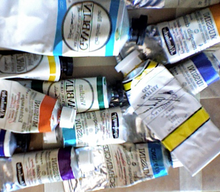
Old masters usually applied paint in layers known every bit "glazes", a method also simply called "indirect painting". This method was first perfected through an adaptation of the egg tempera painting technique (egg yolks used as a binder, mixed with paint), and was applied by the Early on Netherlandish painters in Northern Europe with pigments usually ground in linseed oil. This arroyo has been called the "mixed technique" or "mixed method" in modern times. The commencement glaze (the underpainting) is laid down, oftentimes painted with egg tempera or turpentine-thinned paint. This layer helps to "tone" the canvas and to encompass the white of the gesso. Many artists use this layer to sketch out the composition. This first layer can be adjusted before proceeding farther, an advantage over the "cartooning" method used in fresco technique. After this layer dries, the creative person might then proceed past painting a "mosaic" of colour swatches, working from darkest to lightest. The borders of the colors are composite together when the "mosaic" is completed then left to dry earlier applying details.
Artists in later periods, such as the Impressionist era (late 19th century), ofttimes expanded on this wet-on-wet method, blending the wet pigment on the sheet without following the Renaissance-era arroyo of layering and glazing. This method is also called "alla prima". This method was created due to the advent of painting outdoors, instead of inside a studio, because while outside, an artist did not have the time to let each layer of paint dry out before adding a new layer. Several gimmicky artists utilise a combination of both techniques to add bold colour (wet-on-wet) and obtain the depth of layers through glazing.
When the image is finished and has stale for up to a twelvemonth, an creative person often seals the work with a layer of varnish that is typically fabricated from dammar gum crystals dissolved in turpentine. Such varnishes can be removed without disturbing the oil painting itself, to enable cleaning and conservation. Some contemporary artists decide not to varnish their work, preferring the surface unvarnished.
Examples of famous works [edit]
-

-
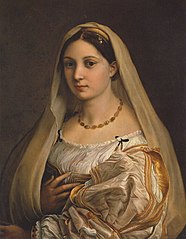
-
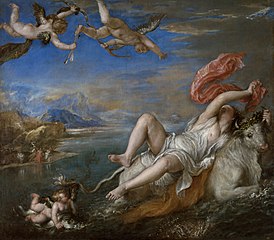
-
-
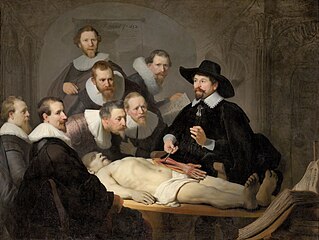
-

-
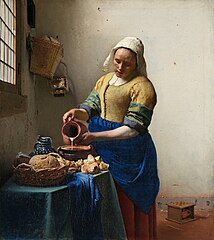
-

-
-

-
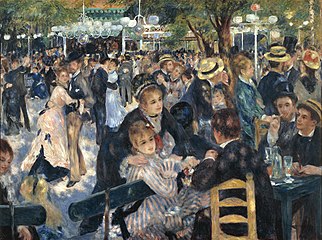
-
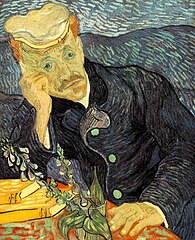
-

-

-

-

-

-

Motive from Tartu, Villem Ormisson, 1937
-

Notes [edit]
- ^ Osborne, 787
- ^ Archæology, Current Globe (6 July 2008). "World'south oldest use of oil paint found in Afghanistan". Earth Archaeology . Retrieved x August 2020.
- ^ "Synchrotron light unveils oil in aboriginal Buddhist paintings from Bamiyan". www.esrf.european union . Retrieved 12 April 2020.
- ^ "Afghan caves hold earth's first oil paintings: expert". world wide web.abc.cyberspace.au. 25 Jan 2008.
- ^ Apr 2008, Alive Science Staff 22 (22 Apr 2008). "Earliest Oil Paintings Discovered". livescience.com.
- ^ Borchert (2008), 92–94
- ^ Osborne, 787, 1132
- ^ Osborne, 787
- ^ Osborne, 787-788
- ^ Haaf, Beatrix (1987). "Industriell vorgrundierte Malleinen. Beiträge zur Entwicklungs-, Handels- und Materialgeschichte". Zeitschrift für Kunsttechnologie und Konservierung. i: 7–71.
References [edit]
- Borchert, Till-Holger. Van Eyck. London: Taschen, 2008. ISBN 3-8228-5687-viii
- Osborne, Harold (ed), The Oxford Companion to Art, 1970, OUP, ISBN 019866107X
Farther reading [edit]
- Chieffo, Clifford T.:Contemporary Oil Painter's Handbook, Prentice Hall, 1976
- The Creative person's Handbook of Materials and Techniques, comprehensive reference volume by Ralph Mayer (1940)
Source: https://en.wikipedia.org/wiki/Oil_painting
Posted by: ammonsinho1956.blogspot.com



0 Response to "How Did The Invention Of Oil Paint In Metal Tubes Change Art In The 1800s?"
Post a Comment